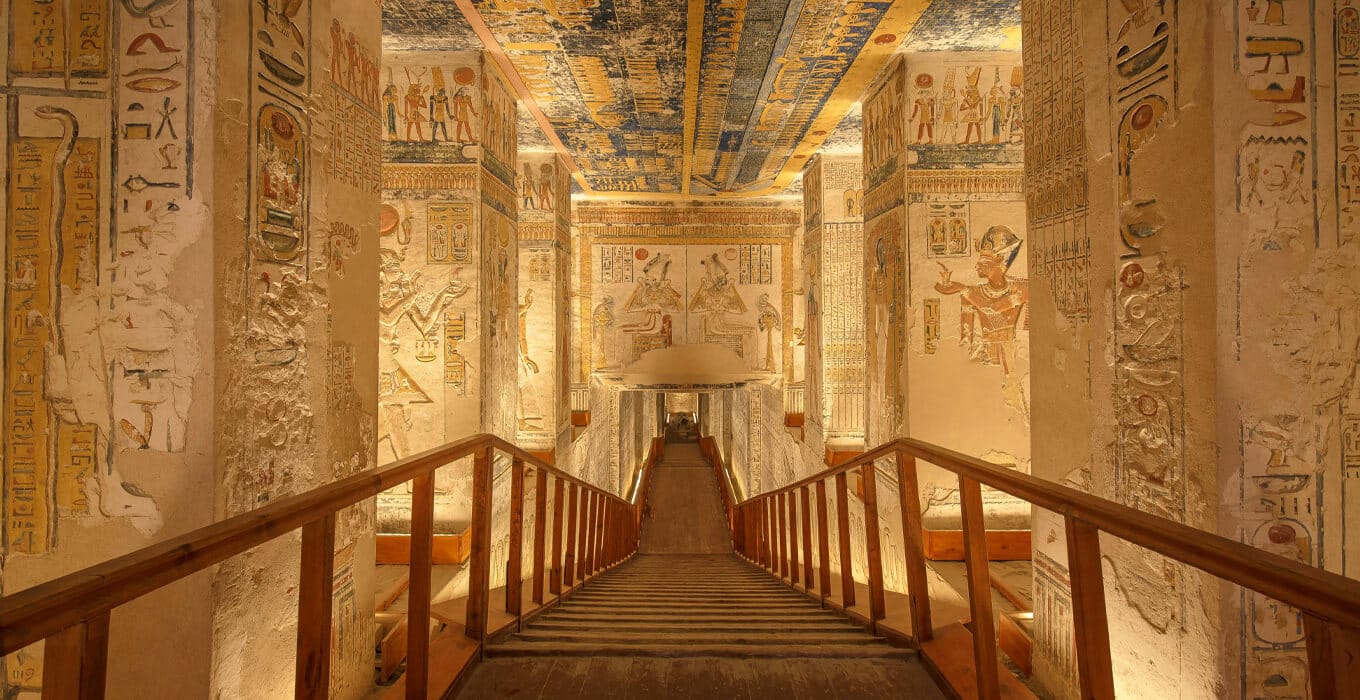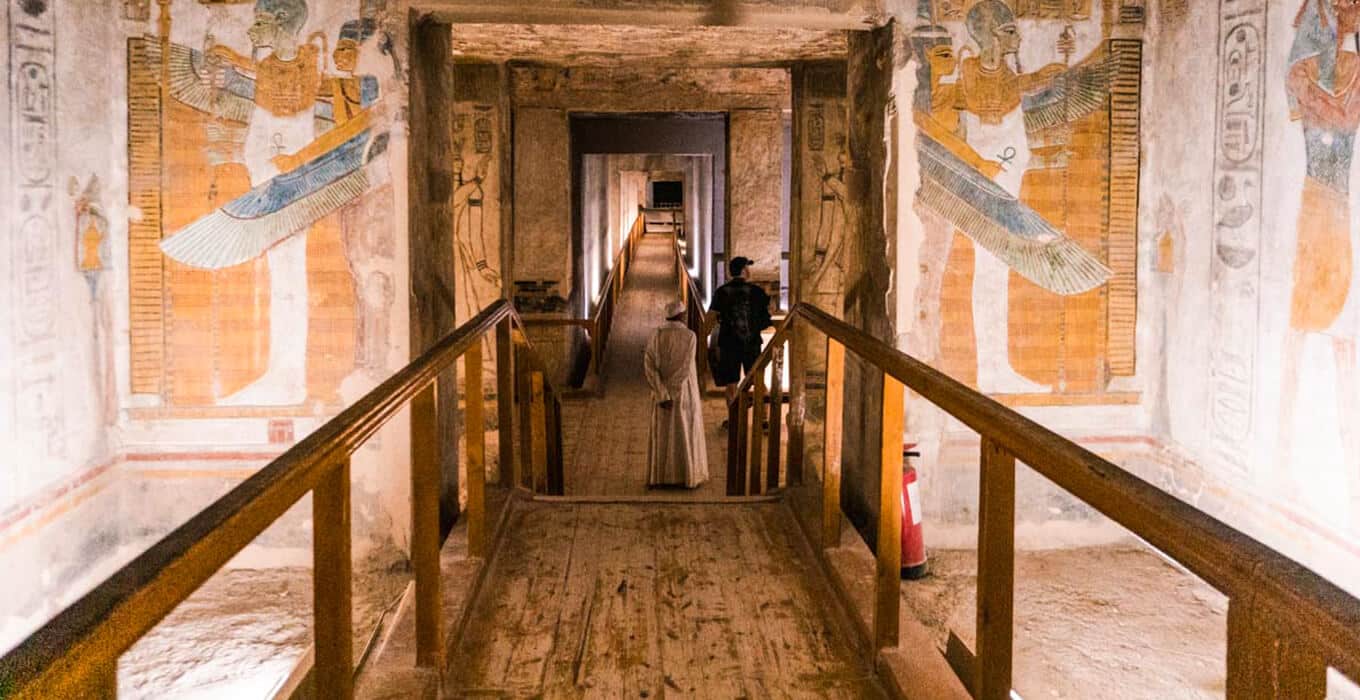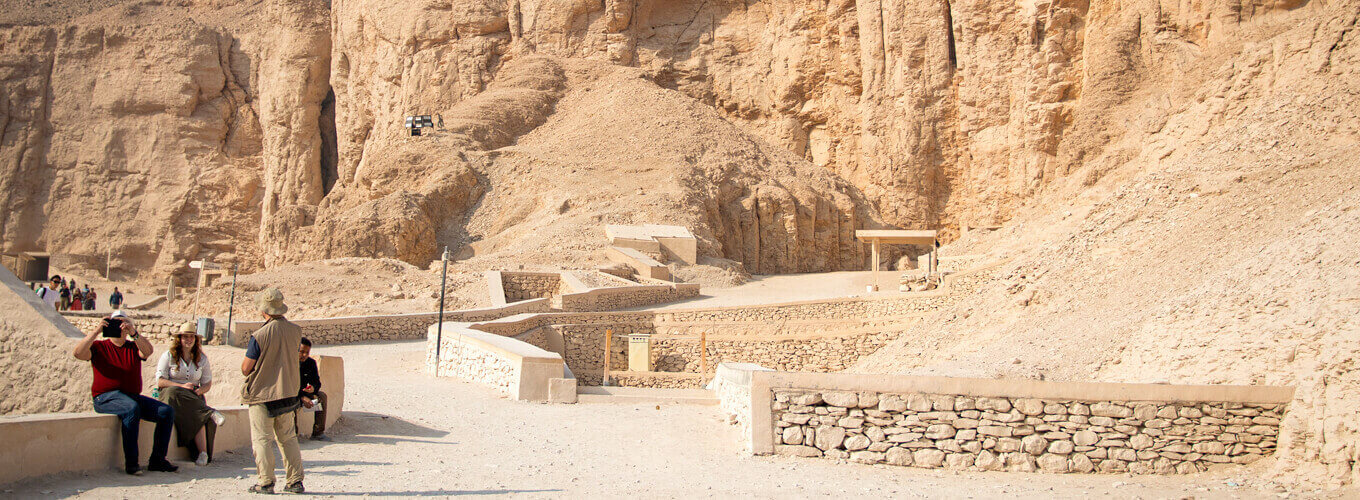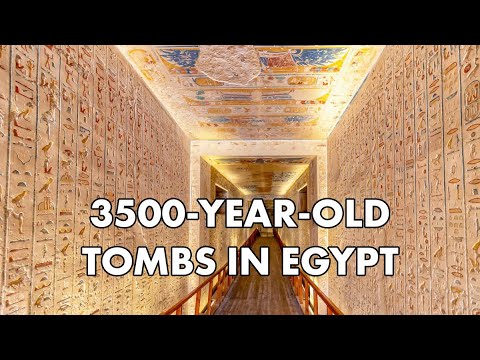The Valley of the Kings in Luxor, Egypt, is a famous spot for archaeology. It has over 65 tombs and chambers. These were the final rest for powerful pharaohs from the New Kingdom period (c.1550–1069 BC). Famous pharaohs like Tutankhamun, Ramses the Great, and Seti I were buried here.
This place was picked for its sacred links and hidden spot. For centuries, it has drawn historians, archaeologists, and visitors. It shows a lot about ancient Egyptian history and culture.
Key Takeaways
- The Valley of the Kings in Luxor, Egypt, has over 60 tombs of pharaohs from the 18th, 19th, and 20th dynasties of the New Kingdom period.
- Famous kings buried in the valley include Tutankhamun, Ramses II, and Seti I, along with powerful nobles and members of the royal family.
- The valley was carefully chosen as a burial site due to its remote location and sacred associations with the goddess Hathor and the concept of rebirth.
- The Valley of the Kings has been a focus of Egyptological exploration and archaeological excavations since the late 18th century.
- The area gained significant attention after the discovery of Tutankhamun’s tomb in 1922, which revealed a vast treasure trove of artifacts and insights into ancient Egyptian culture.
What is the Valley of the Kings?
Location and Selection
The rulers of the New Kingdom were buried in a dry river valley across from Thebes (now Luxor). This place was chosen for its special meaning. The west bank of the Nile was seen as sacred because of the sun god’s journey into the underworld.
The valley was also near a pyramid-shaped peak, sacred to Hathor. Its hidden location made it perfect for the pharaohs. They wanted to keep their tombs and treasures safe from thieves.
The Valley of the Kings was a royal burial site for pharaohs and elites from 1539-1075 B.C. Tutankhamun’s tomb was found in 1922, one of 62 discovered by then. In 2005, a new tomb (KV 63) was found near Tutankhamun’s.
It’s thought that one more tomb, of Ramses VIII, is still hidden. Despite efforts to protect them, most royal tombs were robbed by the 20th dynasty’s end. Diodorus Siculus, a Greek writer from 60 B.C., saw the damage during his visit.

History and Significance
The Valley of the Kings in Luxor, Egypt, is a place of deep history. It was the royal burial spot for over 500 years, starting with Thutmose I (c.1504–1492 BC) of the 18th Dynasty. The New Kingdom’s powerful kings, from the 18th to the 20th dynasties, were buried here. They wanted to avoid the tomb robbing that happened in the Old and Middle Kingdoms.
The Valley of the Kings has two parts: the East and West Valleys. The East Valley is famous and has most of the tombs. The New Kingdom pharaohs made a new plan to hide their tombs in this valley. They did this to stop tomb robbers.
|
Key Facts |
Details |
|
Number of Tombs |
62 known tombs, each showing different designs and decorations |
|
World Heritage Site |
Named in 1979 as part of ancient Thebes, including Luxor, the Valley of the Queens, and Karnak |
|
Famous Tombs |
|
The Valley of the Kings shows the greatness of the New Kingdom in ancient Egypt. It gives us a special look at how people were buried and what they believed in back then.
Exploring the Tombs
The Valley of the Kings in Luxor, Egypt, is famous for its detailed funerary artifacts and hieroglyphics. These underground tombs were made to hold the mummies of pharaohs. They also had treasures and relics to help them in the afterlife.
Tombs of famous pharaohs like Tutankhamun, Ramses the Great, and Seti I are well-preserved. Visitors can see the amazing artwork and learn about the grandeur of these pharaohs.
Tomb Highlights
- The tomb of Tutankhamun (KV62), found in 1922, is a major archaeological discovery. It showed a lot of funerary artifacts.
- The tomb of Ramses the Great (KV7) is big and has lots of decorations. It shows the power and beauty of this famous pharaoh.
- The tomb of Seti I (KV17) is a work of art. Its bright wall paintings and detailed hieroglyphics tell us about the afterlife beliefs back then.
|
Tomb |
Pharaoh |
Ticket Price (EGP) |
|
KV62 |
Tutankhamun |
500 |
|
KV7 |
Ramses the Great |
Included in main ticket |
|
KV17 |
Seti I |
1800 |
Only a few of the over 60 tombs in the Valley of the Kings are open to visitors. But seeing these detailed and important chambers is an amazing experience. It takes you back to the greatness of ancient Egyptian civilization.
Valley of the Kings in Luxor Egypt
The Valley of the Kings is on the west bank of the Nile River, near Thebes. It shows the greatness of ancient Egyptian civilization. This UNESCO World Heritage Site was the capital during the New Kingdom period. It’s famous for its royal tombs that tell us about the pharaohs’ history and culture.
There are 63 royal tombs in the valley, each a masterpiece. They date back to the New Kingdom period (1550–1069 BC). These tombs were made for the pharaohs’ afterlife journey. Visitors leave about 2.8g of sweat, which can harm the tombs’ reliefs and paintings.
The Tomb of Ramses VII (KV 1) is one of the highlights. It’s 44.3m long and has well-preserved texts and rituals. The Tomb of Ramses IV (KV 2) has a big red granite sarcophagus and a beautiful blue ceiling with the goddess Nut. The Tomb of Ramses IX (KV 6) is the most visited, with a big entrance and a long corridor.
Dr. Kent Weeks and the Theban Mapping Project work hard to protect the tombs. They manage visitor numbers and keep the valley safe. This shows their dedication to saving this ancient site for the future.
The Valley of the Kings in Luxor, Egypt, is a place of wonder. It lets visitors see the ancient Egyptian heritage and art. As a UNESCO World Heritage Site, it continues to amaze and inspire everyone who visits.

Architecture and Design
The underground tombs in the Valley of the Kings are amazing examples of ancient engineering and religious symbols. They were carved into the limestone hills to keep the pharaohs’ tombs safe from robbers. This place is in Luxor, Egypt.
Tomb Construction
The Egyptians picked this hidden spot for the tombs to keep them safe. The valley was surrounded by a pyramid-shaped peak. This peak was a symbol of rebirth and eternal life, linked to the goddess Hathor.
Ineni, a high official, talked about the tomb’s construction. He said it was done secretly, so no one knew or heard anything.
Each tomb is a special work of art, with sizes ranging from small to huge. Inside, you’ll find beautiful reliefs, hieroglyphics, and scenes. These show the dead’s journey to the afterlife and their life on earth.
Over time, the design of the tombs changed. Early ones had straight paths, but later ones had twisting corridors. This shows how the Egyptians kept trying to protect their pharaohs’ tombs.
|
Tomb Characteristic |
Details |
|
Number of Tombs |
Over 60 known tombs located in the Valley of the Kings |
|
Construction Period |
New Kingdom period, from the 16th to 11th centuries BCE |
|
Tomb of Tutankhamun |
Discovered in 1922, renowned for being nearly intact and filled with treasures |
|
Tomb Decorations |
Intricate reliefs, hieroglyphics, and scenes depicting the deceased’s journey to the afterlife, daily life, and encounters with gods |
|
Tomb Design Evolution |
Earlier tombs had a straight axis, while later tombs had corridors that changed direction |
Visiting the Valley of the Kings
Many travelers love visiting the Valley of the Kings in Luxor, Egypt. It’s on the west bank of the Nile River. Here, you can see how ancient Egyptian pharaohs were buried.
You can join a guided tour or take a taxi to get there. Once you arrive, you need to buy entrance tickets. These tickets let you see three tombs for free. To see more, like Tutankhamun’s tomb, you have to pay extra.
Then, you get on a tram to the tombs. This takes you to the amazing chambers of the ancient pharaohs.
|
Ticket Type |
Price (EGP) |
Includes |
|
Standard Entrance Ticket |
200 |
Access to 3 open tombs |
|
Tutankhamun’s Tomb |
250 |
Additional ticket required |
|
Photography Ticket |
300 |
Allows photography in most tombs |
|
4 Tombs (incl. Tutankhamun) |
600 – 750 |
Access to additional tombs |
|
Seti I’s Tomb |
1,000 |
Additional ticket required |
The best time to visit the Valley of the Kings is from December to January. The weather is nice then. Try to come around 11 a.m. to avoid the crowds.
“The Valley of the Kings is an active archaeological site, with ongoing excavations and hopes for more discoveries in the future.”
Activities and Experiences
Guided Tours
Visiting the Valley of the Kings is better with a guided tour from an Egyptologist. They share deep knowledge about the site’s history and its importance. You also get to see some amazing tombs.
These tours often let you into tombs that are usually off-limits. It makes your visit more special and private.
There’s also a Luxor Pass that gives you access to the Valley of the Kings and other big sites in Luxor. This pass saves you time and money. It lets you see the area’s rich culture at your own speed.
Photographers will love the Valley of the Kings. It’s perfect for taking pictures of the detailed hieroglyphs and the stunning tombs. You’ll make memories that will last a lifetime.
- Guided tours led by knowledgeable Egyptologists
- Exclusive access to select tombs
- Luxor Pass for convenient access to multiple sites
- Opportunities for captivating photography
“The guided tour of the Valley of the Kings was the highlight of my trip to Luxor. The Egyptologist’s insights brought the history to life and allowed me to fully appreciate the grandeur of these ancient tombs.”
Surrounding Attractions
The Valley of the Kings is the top spot in Luxor’s west bank. But there are many other amazing places to see too. Along the Nile River, you’ll find ancient temples, monuments, and archaeological sites. These places let you dive deep into ancient Egypt’s history and culture.
Don’t miss the Temple of Hatshepsut. It’s a huge temple built for a famous female pharaoh. The design and carvings are stunning, showing the power and achievements of Egypt’s rulers.
Close by, the Colossi of Memnon are two huge statues of Pharaoh Amenhotep III. They have been standing for over 3,400 years. These statues are a sight to behold, showing the skill of ancient Egyptian artists.
On the other side of the Nile, Luxor awaits. Here, you can see the huge Karnak Temple Complex. It’s full of temples, obelisks, and sacred lakes. The Luxor Temple is another place you should visit. It shows the religious and political life of Thebes, the old Egyptian capital.
|
Attraction |
Location |
Admission Fee |
|
Temple of Hatshepsut |
Luxor’s West Bank |
200 EGP (16 AUD/12 USD) |
|
Colossi of Memnon |
Luxor’s West Bank |
100 EGP (8 AUD/6 USD) |
|
Karnak Temple Complex |
Luxor |
240 EGP (19 AUD/14 USD) |
|
Luxor Temple |
Luxor |
200 EGP (16 AUD/12 USD) |
Visiting these sites lets you explore the amazing history and legacy of ancient Egypt. It makes your trip to Luxor’s west bank unforgettable.
Conclusion
The Valley of the Kings in Luxor, Egypt, is a place of wonder. It shows us the greatness of ancient Egyptian life. Here, the tombs of powerful pharaohs from the New Kingdom are found. They give us a peek into their creativity, skill, and beliefs.
This site is a UNESCO World Heritage Site. It has been important since 1550 BC to 1080 BC. Many pharaohs of the New Kingdom left their mark here. The discovery of King Tutankhamun’s tomb has shown us much about ancient Egyptian culture.
Visiting the Valley of the Kings in Luxor is a must for those interested in Egypt’s history. It’s a deep dive into the past. You get to see the amazing things ancient Egyptians achieved.
Read our related articles:


